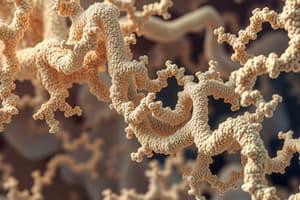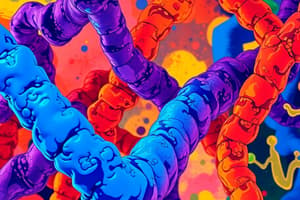Podcast
Questions and Answers
What participates in hydrogen bonding within collagen?
What participates in hydrogen bonding within collagen?
- Proline residues
- Hydroxyproline residues (correct)
- Lysine residues
- Glycine residues
How is the helix in a strand of collagen stabilized?
How is the helix in a strand of collagen stabilized?
- By the absence of hydrogen bonds
- By steric repulsion of proline and hydroxyproline residues
- By hydrogen bonds between proline and glycine residues
- By the pyrrolidine rings of proline and hydroxyproline residues (correct)
What provides rigidity to collagen and makes up to 30% of its composition?
What provides rigidity to collagen and makes up to 30% of its composition?
- Hydroxyproline and lysine
- Glycine and proline
- Proline and hydroxyproline (correct)
- Glycine and hydroxyproline
Which vitamin acts as a cofactor in collagen hydroxylation by enzymes?
Which vitamin acts as a cofactor in collagen hydroxylation by enzymes?
What is a consequence of vitamin C deficiency in relation to collagen?
What is a consequence of vitamin C deficiency in relation to collagen?
What is the main difference between fibrous proteins and globular proteins based on the text?
What is the main difference between fibrous proteins and globular proteins based on the text?
What is the significance of the triple-stranded helical structure of collagen as mentioned in the text?
What is the significance of the triple-stranded helical structure of collagen as mentioned in the text?
Which type of collagen is predominant in bones, tendons, and skin among the options below?
Which type of collagen is predominant in bones, tendons, and skin among the options below?
Which amino acid is most abundant in the amino acid sequence of collagen alpha-chains according to the text?
Which amino acid is most abundant in the amino acid sequence of collagen alpha-chains according to the text?
What is the most distinctive feature of wool (keratin) based on its structure as mentioned in the text?
What is the most distinctive feature of wool (keratin) based on its structure as mentioned in the text?
Flashcards are hidden until you start studying
Study Notes
Fibrous Proteins
- Long, rod-shaped, tough, and insoluble in water
- Consist mostly of a single secondary structure
- Examples: keratins, which have structural and protective roles
- Silk (fibroin) mainly contains ß-sheets; wool (keratin) is mostly alpha-helix
Collagen
- Most abundant vertebrate protein
- Major structural protein in the extracellular matrix
- Typical collagen: Long, inelastic, stiff, triple-stranded helical structure
- ~ 3000 Å long and 15 Å in diameter
- Consists of three polypeptide chains called alpha-chains
- Each alpha-chain is over 1000 residues long, and they may be identical or different
- Alpha-chains are left-handed polypeptide helices with 3.3 amino acid residues per turn
- Three alpha-chains wind around each other in a characteristic right-handed triple helix
- Vertebrates have about 25 types of alpha-chains, coded by different genes, forming at least 27 types of collagen molecules
Collagen Types
- Types I, II, and III collagen make up 90% of all collagens
- Type I collagen: predominant in bones, tendons, and skin
- Type II collagen: found in cartilage
- Type III collagen: found in blood vessels
Amino Acid Sequence
- Amino acid sequence in alpha-chain often Gly-X-Y
- X is often proline and Y is often 3- or 4-hydroxyproline or 5-hydroxylysine
- Glycine makes up about one-third of the amino acid residues, provides flexibility
- Proline and hydroxyproline provide rigidity and together comprise up to 30% of collagen
Collagen Structure
- Hydrogen bonds are absent within a strand of collagen
- The helix is stabilized by steric repulsion of the pyrrolidine rings of proline and hydroxyproline residues
- The pyrrolidine rings of proline and hydroxyproline residues prevent interference with each other in the helical conformation
- The collagen helix forms a superhelical cable with three strands winding around each other
- The stability of the collagen superhelix is maintained by hydrogen bonds between the peptide NH groups of glycine residues and the CO groups of residues on the other chains
- The hydroxyl groups of hydroxyproline residues also participate in hydrogen bonding within collagen
Hydroxylation
- Hydroxylation by enzymes: prolyl-4-hydroxylase and lysyl-hydroxylase
- Ascorbate (vitamin C) acts as a cofactor
- Hydroxylation stabilizes collagen
- Vitamin C deficiency causes scurvy
Collagen Related Disease
- Scurvy disease: results from vitamin C deficiency, which leads to inactive hydroxylase enzyme, no hydroxylation of proline and glycine, and no triple helix formation
- One of the oldest neurotoxic diseases known to Man, results from excessive consumption of the chickling pea, Lathyrus sativus, and certain related species
Studying That Suits You
Use AI to generate personalized quizzes and flashcards to suit your learning preferences.




